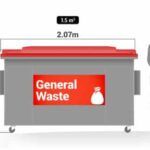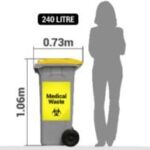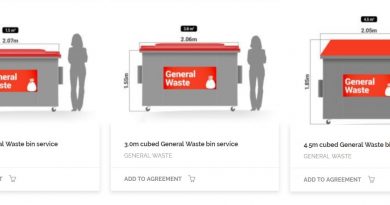Waste Disposal Service 🗑️ – Commercial Bin Hire And Collections For SME
Energy Disrupter
Waste Disposal Service 🗑️: In our usual blogs, we cover lots of issues relating to disposal waste and recycling. We have covered issues such as plastic waste, recycling approaches and whether modern landfills could actually be good for the environment (by capturing gases and creating electricity).
We always try to be positive about the global issues with disposal waste as in many areas, tech and new approaches are really helping. In nearly every area, recycling is really improving and we are reaching better environmental outcomes.
>Download Now: Free PDF Business Owners Guide To General Waste Bin Services
However, in some of our recent blogs on plastic waste, we have argued that solely recycling does not cut it and that the situation at hand certainly requires us to reduce waste as whole to help the environment.
In today’s blog, we will look at how much waste we actually produce globally and if the waste we produced has already peaked.
What Waster can offer to small and medium customers
Waster offers disposal waste bins and all recycling services to small and medium Aussie companies. You can easily book your bin pickups online.
As all our services are based on flexible 30 day agreements, you will never need to sign a long term contract or worry about hidden roll over clauses again.
You can see your bin size and collection options by pressing the button as below:
Disposal waste: is global waste increasing or decreasing?
If you read the press, you may be unaware as to whether the global environmental issue is getting better or worse in 2022. To be honest, I do not really know either as there are so many positive recycling steps being taken – but the global population continues to rise.
According to the website Smithsonian, the news is, well… not good:
“A recent World Bank report projected that the amount of solid waste generated globally will nearly double by the year 2025, going from 3.5 million tons to 6 million tons per day. But the truly concerning part is that these figures will only keep growing for the foreseeable future. We likely won’t hit peak garbage—the moment when our global trash production hits its highest rate, then levels off—until sometime after the year 2100, the projection indicates, when we produce 11 million tons of trash per day.”
Is there any good news, at least?
The good news is that as societies reach a given level of economic development, the amount of rubbish that they produce stops growing.
“In many of the world’s wealthy countries, the average person produces slightly more than 3 pounds of solid waste per day, and that number isn’t estimated to change significantly going forward.”
The other good news is that by implementing smart recycling initiatives, countries can significantly reduce the trash per person that they produce.
For example, Japan produces roughly a third less trash per person than a US citizen. This is based on many things such as high density living but also stricter recycling codes and processes.
As the population in much of the developed world and developing world is growing at a slower pace (and many countries are already seeing real population decreases), we can expect to see global trash production peak around 2100.
Conclusion
If disposal waste issues peak around 2100, the question is, can our environment cope in the mean time without real efforts to clean it up?
Recycling and waste disposal approaches are definitely improving, but to be honest, we are in uncharted territory!
For an insight into the issues caused by continually increasing waste volumes globally and pollution, see a video as below from the BBC on how waste from all around the world is ending up in the pristine Arctic:
[embedded content]
When you think of waste disposal services, we tend to think more of bins and trucks. But a small enzyme could transform the global approach to dealing with plastic pollution.
Plastic is (as you would be aware of from reading our blogs) becoming the biggest environmental problem on earth. The fact that it survives for 100s of years before decomposing – combined with its appeal to animal and fish life – means that it is entering the food chain in ever greater numbers.
We even covered in a recent blog how coral eats plastic, and this is causing damage to the Great Barrier Reef.
Some things happen through luck coincidences
There have been some very luck inventions in recent history (i.e., when the scientists come up with something unexpected). Great examples include the post it note, which apparently was based on a glue that was just not sticky enough.
The laser was also an invention that at the beginning was seen as having no practical uses! Now it is in everything.
Could an enzyme replace waste disposal services?
Just as the situation is looking desperate due to no real waste disposal services on a global scale for plastic, science may be about to save the day.
The UK based Independent newspaper reports that scientists have come up with an enzyme that can actually “eat” plastic.
“The substance is based on an enzyme – a “biological catalyst” – first produced by bacteria living in a Japanese recycling centre that researchers suggested had evolved it in order to eat plastic.
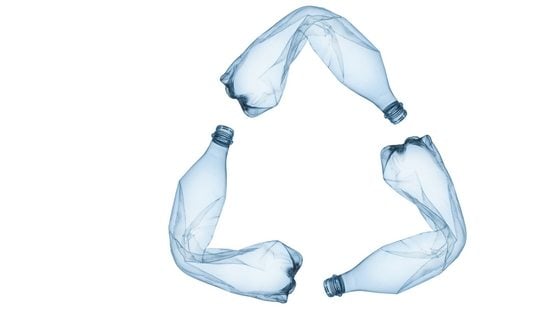

“Dubbed PETase for its ability to break down the PET plastic used to make drinks bottles, the enzyme accelerated a degradation process that would normally take hundreds of years.
Luck was definitely involved in the process as “University of Portsmouth biologist Professor John McGeehan and his colleagues accidentally created a super-powered version of the plastic-eating enzyme.”
The new enzyme can digest both PET and PEF.
There is still a long road of research and testing required before this can be a real solution on industrial levels:
“While there is still a way to go before you could recycle large amount of plastic with enzymes, and reducing the amount of plastic produced in the first place might, perhaps, be preferable, this is certainly a step in a positive direction and very exciting science to boot,” said Dr Oliver Jones, an analytical chemist at RMIT University in Melbourne.
We will, of course, keep you informed on this interesting development.
What Waster thinks
This is certainly promising news when you consider the magnitude of the plastic pollution issue. We need to work as a society and globally to come up with thorough solutions to these issues.
Plastic pollution cannot be kept in one area. It enters the seas and oceans and impacts everyone. So, we need international solutions and waste disposal services that really work for the environment.
You can see a short video on the enzyme and how it can work below:
[embedded content]
More on waste disposal service
At Waster, we always seek to promote recycling to our clients as a way to keep waste management costs down and help the environment. In this part of the blog, I want to ask the question, are we slightly missing the point? (i.e., is sensible waste disposal the thing we should focus on first?)
I was shocked to read this week that the Great Pacific Garbage Patch is getting bigger and bigger. If you do not know what this is, you will be shocked to find out.
It is a huge floating load of rubbish – in the middle of the Pacific Ocean.
According to Wikipedia:
“It is a gyre of marine debris particles in the central North Pacific Ocean discovered between 1985 and 1988. It is located roughly between 135°W to 155°W and 35°N to 42°N.
“Estimates of size range from 700,000 square kilometres (270,000 sq mi) (about the size of Texas) to more than 15,000,000 square kilometres (5,800,000 sq mi) (0.4% to 8% of the size of the Pacific Ocean).”
Should we focus more on plain and simple waste disposal service?
The presence and expansion of the great floating mess makes me ask – should we as a society and globally really focus on sensible waste disposal first. Take that as a first step and then move our focus to recycling?
The patch appears to be getting out of control
A recent report by the BBC suggests that the issue is getting bigger and bigger.
“Predictions suggest a build-up of about 80,000 tonnes of plastic in the “Great Pacific Garbage Patch” between California and Hawaii.
“This figure is up to sixteen times higher than previously reported, say international researchers.
“One trawl in the centre of the patch had the highest concentration of plastic ever recorded.”
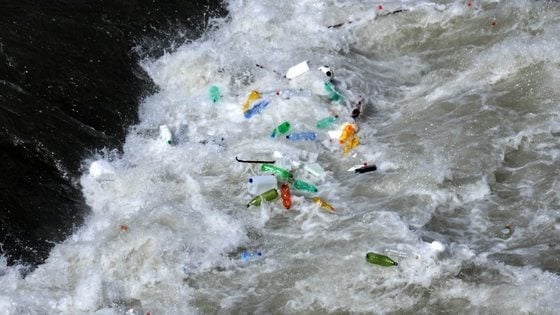

Even the experts are shocked by the growth of the issue:
“Erik van Sebille of Utrecht University in the Netherlands, who is not connected with the study, said the amount of plastic discovered was “staggering”.”
Is there a solution?
Fundamentally, we need to globally stop the plastic waste from entering the ocean. This can be based on a number of approaches, which are reducing or eliminating plastic, providing real recycling solutions or with the lack of these solutions, providing secure waste disposal.
It is time that waste disposal for this plastic was seen as a bio-security risk or health risk by the international community, given the increasing amount of plastic in the environment and foodchain.
For example, a recent report showed that even commercial bottled water in developed countries contains micro-plastics. Sea life is also proven to consume plastic.
International response needed
To prevent plastics from entering the ocean, a joined up international response is needed.
This would involve provision of recycling solutions or if not possible, proper waste disposal such as landfills as an interim measure in developing nations.
The worrying thing is that this issue has not even started to be discussed, let alone financial arrangements to rectify it found.
If it is your first time hearing about this issue, you can check out the short explainer video below:
[embedded content]
See our blog on Australia recycling and how trade issues can impact our environment. Also, see our blog on phasing out plastics from supermarkets.
Waste disposal service
I think we all want to help the environment if it is not too difficult for us and also if it can help us save money at the same time. Sounds too good to be true? It does not have to be. I think we have all read scary stories about how the Great Barrier Reef is being impacted by climate change and pollution and it can be a bit depressing. However, there are easy things we can do to help such as organising a flexible and reliable waste disposal service for our business. Check out our online store by clicking the blue button located above for all your required waste disposal services and recycling needs.
Waste disposal service: importance in light of damage to the environment
You realise the importance of a reliable waste disposal service when you read about the damage being done to the natural environment and our seas. The Queensland Government has provided the following figures which hammer home the damage incorrect waste disposal service can cause.
We quote below:
“Australia’s beautiful beaches are being marred by more and more rubbish.
“It’s not only heavily-used beaches which are affected. A 1991 survey of 26 remote Great Barrier Reef islands found 5656 items of rubbish. Among the plastic, glass and metal debris were 725 glass bottles, 1066 plastic fragments, 247 aluminium cans and plastic cups, 919 thongs and one bar fridge.
“There is a lot of junk floating around out there! Not only is garbage unsightly in otherwise unspoilt environments and a hazard to ships and to divers, it also poses a real threat to wildlife.
“Plastics which generally make up about 60 percent of rubbish are the worst offenders. An estimated 100 000 marine mammals and turtles are killed by plastic litter every year around the world.
To add
“Fishing line, netting, rope, bait box packaging bands and so on trap and strangle animals. Large marine animals such as seals and dolphins can starve to death when muzzled by plastic litter.” See out blog on plastic recycling.
“Plastic is also eaten. A dead pygmy sperm whale found on a New South Wales beach had a plug of plastic bags in its gut. Presumably these items were mistaken for squid, the sperm whale’s main food. A sperm whale found dead on a North American beach was discovered to have starved to death because a plastic gallon bottle which it had swallowed had plugged its small intestine. The animal was full of plastic material ranging from other plastic bottles to 12m of nylon rope.
“Plastic bags on the ocean floor take 10-20 years to decompose. Plastic bottles take much longer. Because of this, one piece can kill more than one animal. An animal killed by swallowing plastic will decompose long before the plastic does, leaving the plastic free to kill again.
“The disposal of plastics into the sea is prohibited under the International Convention for the Prevention of Pollution from Ships (known as MARPOL). The disposal of all other types of garbage (including metals, glass and food) is prohibited within 12 nautical miles of nearest land including most of the Great Barrier Reef. The law provides for fines of up to $1 million for companies and $200,000 for individuals illegally discharging garbage at sea.”






